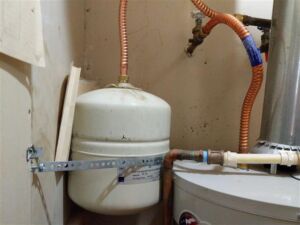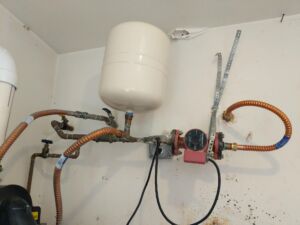
The expansion tank provides a space for the expanding water to move into, preventing a significant increase in pressure. As the water heats up and expands, it flows into the expansion tank. When the water cools, the tank releases the stored water back into the system.
Expansion tanks are typically recommended for closed-loop water heating systems, especially those connected to a backflow preventer or pressure reducing valve. They are commonly used with traditional tank-style water heaters and can also be beneficial for tankless water heaters, depending on the specific installation.
Tankless water heaters, which heat water on demand, may not require expansion valves in typical residential applications. However, some tankless water heaters may have built-in or require external devices to address thermal expansion, such as pressure relief valves or expansion tanks. Some tankless water heater installations may benefit from the use of expansion tanks, especially if they are installed in closed-loop systems with check valves that prevent water from flowing back into the municipal supply. This situation can lead to increased pressure due to thermal expansion. In certain jurisdictions or installations, pressure relief valves may be required to address thermal expansion in tankless water heater systems.

When water is heated, it expands. Without an expansion tank to absorb this expansion, the pressure within the water heater and the associated plumbing system can increase significantly. This can lead to pressure-related problems. The increased pressure can cause stress on various components of the plumbing system such as the water heater itself, valves, fittings, hoses and pipes. Over time, this stress can lead to leaks or damage to the water heater and the surrounding plumbing. The added stress from thermal expansion can contribute to inefficient operation and premature failure of the water heater. Constant pressure fluctuations and stress on the system can lead to suboptimal performance and increased energy consumption. This may result in the need for repairs or even a complete replacement of the water heater.
In some cases, the temperature and pressure relief valve (T&P valve) on the water heater may discharge water as a safety measure to relieve excess pressure. This discharge can cause water wastage and potential water damage.
Many local plumbing codes and regulations mandate the installation of expansion tanks in certain water heater setups. Failure to comply with these codes can result in fines, penalties, or the need to retrofit the system to meet regulatory requirements.
Expansion tanks are installed on the cold water supply line leading to the water heater, a strategic location chosen for ease of accessibility during maintenance and inspection activities.
Ensuring the expansion tank is mounted in a vertical position is paramount to its effectiveness. This configuration facilitates the proper release of air during the initial setup, mitigating potential issues like waterlogging. Many expansion tanks come equipped with a mounting bracket designed to secure the tank in a stable position. The proper utilization of this bracket is essential to prevent unnecessary movement or stress on the tank. Providing additional support for the pipes connected to the expansion tank is imperative. This precautionary measure prevents undue stress on the connections, promoting the overall stability of the system.
The connection of the expansion tank to the cold water supply line requires the use of appropriate fittings and connectors. Utilizing a union or similar connection ensures a secure fit and enables easy removal and replacement of the expansion tank when necessary.
The pressure setting of the expansion tank must align with system specifications. This involves using a pressure gauge and pump to set the initial pressure, with reference to the manufacturer’s instructions for the recommended pressure setting.
The expansion tank should be installed on the house side of a check valve, if present in the system. This configuration allows the expansion tank to effectively absorb thermal expansion without hindrance within the closed plumbing system. Additionally, the expansion tank should be installed before the temperature and pressure relief (T&P) valve on the water heater. This arrangement ensures proper system functionality and prevents potential issues related to pressure release.
Adherence to local plumbing codes and regulations is a fundamental aspect of expansion tank installation. Compliance with these standards ensures that the installation meets safety and quality requirements. For those unfamiliar with the installation process, seeking the assistance of a qualified plumbing professional is always advisable.
Always refer to the manufacturer’s guidelines and local plumbing codes when determining whether expansion tanks or other devices are necessary for a specific water heater installation, including tankless water heaters. The proper installation and support of expansion tanks in water heater systems are crucial for preventing issues such as pressure buildup, leaks, and premature system failure. The need for these components can vary based on factors such as the type of water heater, the presence of check valves, and local plumbing codes and regulations.
